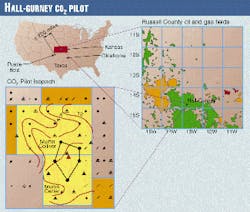Miscible carbon dioxide (CO2) flooding in Central Kansas moved closer to being realized after the US Department of Energy (DOE) included the Hall-Gurney field pilot project, Russell County, as one of 10 new demonstration projects in its Reservoir Class Revisit Program.
The DOE program provides $23 million in funding for 10 projects, while another $46 million will come from industry (OGJ, Oct. 11, 1999, p. 38).
The Hall-Gurney project's share of the DOE money is $1.9 million, while $3.5 million will be contributed by the project team, consisting of the University of Kansas Center for Research Inc., MV Energy LLC, and Shell CO2 Co. Ltd. MV Energy LLC is a venture of Dave Murfin Drilling Co. and Vess Oil Co.
According to DOE, Central Kansas reservoirs have been depleted by effective waterfloods, and the challenge is to implement new recovery technologies before remaining wells are plugged and abandoned. It indicates CO2 miscible displacement has never been applied in Central Kansas reservoirs, so that this demonstration project will be the first test of this technique in these reservoirs.
Hall-Gurney pilot
The target Lansing-Kansas City formation in the Hall-Gurney field is a large carbonate deposition, at a 3,300-3,500 ft depth, with net pay of 22-25 ft in two zones on the target lease. According to Lanny Schoeling, Shell CO2 Co.'s Kansas project leader, a 12-ft thick zone is the likely target for the CO2 pilot flood.
The Hall-Gurney field produces a light 40
The 40-acre lease currently being proposed for the pilot project contains 10 wells of which 6 produce about 41 bo/d from zones above the Lansing-Kansas City (Fig. 1). After bridge plugs are drilled, some of these wells will be recompleted for the Lansing-Kansas City test.
Shell estimates that CO2 flooding in the Central Kansas Uplift could potentially recover 150 million bbl of oil. The Hall-Gurney field has produced about 170 million bbl of oil and its 30-50 million bbl recovery potential from CO2 flooding is sufficiently large to justify anchoring a 220-mile CO2 pipeline from the Postle field, in Texas County, Okla., according to Schoeling.
Studies show that the pilot may recover 75,000 bbl of oil from the five-spot well pattern during CO2 injection, and an additional 20,000 bbl due to the CO2 in the formation after CO2 injection stops.
Phase 1 of the project includes reservoir characterization and determination of the feasibility of the flood. It is scheduled to last 1 year, during which one well will be drilled and cored to ascertain remaining oil saturation. The current estimate is that the target formation has an average residual oil saturation of about 30%, which will be reduced to about 10% by the end of the CO2 injection.
Phase 2, which Schoeling expects to start in the first part of 2001, will last 4 years. During this phase, injected CO2 will displace remaining oil in place from the depleted waterflood zone.
The pilot is planned to have one injector and five producing wells. Five other injectors around the pilot will be used for pressuring the reservoir from the current 500-600 psi to above the minimum miscibility pressure of about 1,250 psi. This will involve the injection of about 200,000 bbl of water.
Porosity in the formation averages 25% and because of the good waterflood response, Schoeling believes fractures are not likely and that the zone will be producing from its carbonate matrix.
Project costs
The budget for the $5.4-million pilot project breaks down as follows:
- Capital costs (equipment, etc.)-$1,068,000.
- Operations (reservoir repressurization, CO2 slug, water-alternating-gas injection, and post waterflood activity)-$769,000.
- CO2 (purchase, and recycle)-$2,023,000.
- Research, data, administration, technology transfer-$1,590,000.
A total of 0.834 bcf of CO2, will be trucked from the Bravo Dome CO2 pipeline terminal in the Postle field, near Guymon, Okla. Mobil Exploration & Producing is operating a successful CO2 flood in that field.
The Hall-Gurney pilot plans to inject CO2 at a rate of 2 MMscfd, with a 1,300 psi injection pressure.
The trucking and CO2 cost is about $3/MMscf, of which $2.50-2.60 is for trucking, and the rest is for the CO2.



